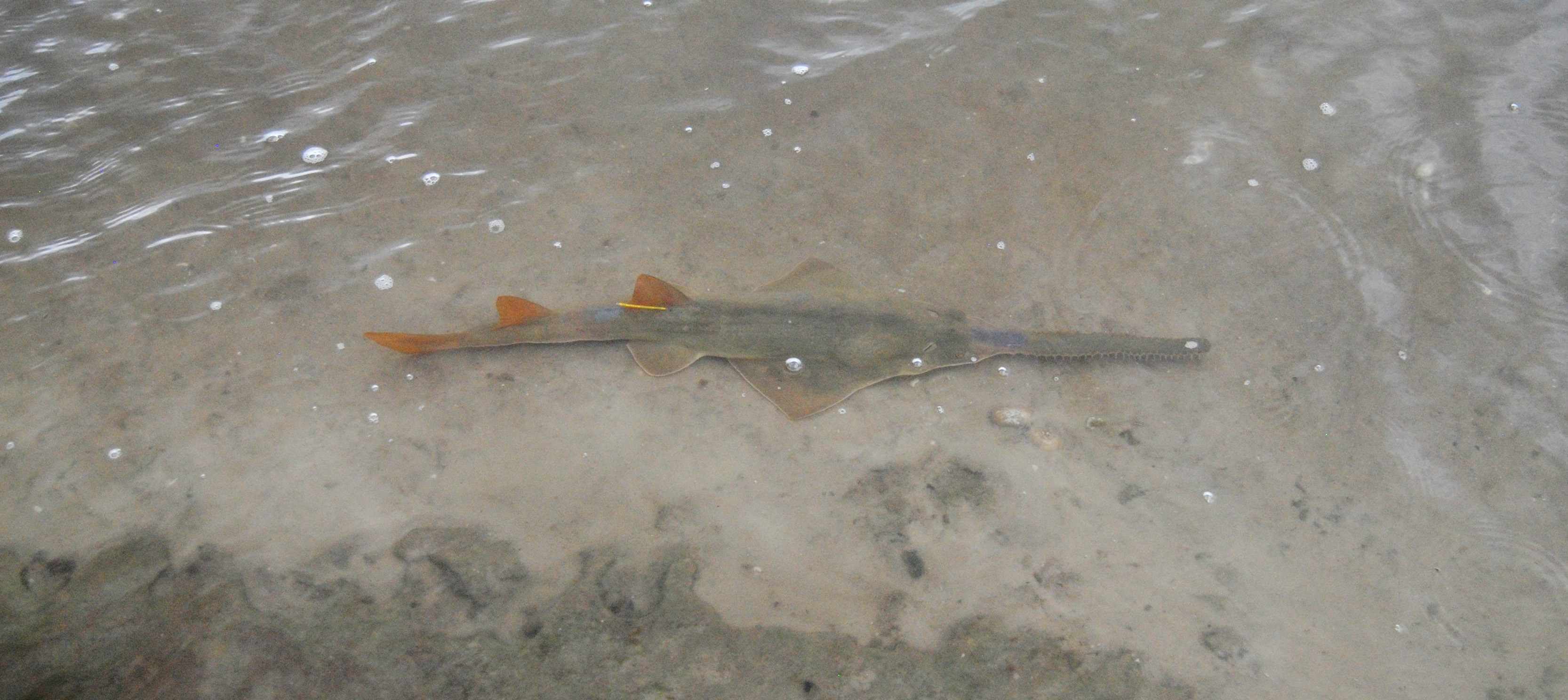A giant of our coasts cut down, now slowly returns

Photo credit: Dana Bethea, NOAA Fisheries
“The sawfish is an abundant species, permanently resident in Indian River, where it does considerable damage to the fishermen by becoming entangled in their nets…Several very large ‘saws’ were seen at Eden, Stuart, and elsewhere, the largest being 6 feet long, thus indicating a fish of 12 or 15 feet. One fisherman has seen them 16 or 17 feet long.
“Another reports that a sawfish 12 ½ feet long and weighing 425 pounds was caught near Eau Gallie in October, 1895. He thinks that fully 300 sawfish were taken in his nets last season.” —The Fisheries of Indian River, Florida, published 1897
Florida is one of the best states in the U.S. to live alongside other big animals and predators of land and sea. If you consider the density of population on our coasts, it may even be a better place than Alaska for human/big animal cohabitation. With that privilege—if you’d call it that, and I would—come manageable dangers and the responsibility to know how to behave around those creatures—which in most cases, for most people, means not to handle them at all, and if they’re encountered, let them go their way as quickly and freely as possible.
As human populations rise in Florida and populations of bear, alligator, panther, manatee and other big critters remain steady or improve thanks to sound management, encounters with these animals are becoming more frequent. One of these species, the smalltooth sawfish, appears to be rebounding from dire straits since being listed under the Endangered Species Act in 2003 during a prolonged decline that started more than a hundred years before. NOAA estimates that sawfish numbers have declined 95 percent, or more, over the past century.
By 2003, reported sightings and encounters were abysmally low around the state. Habitat loss and especially commercial net fishing imperiled the species. Their saws easily catch and tangle in fishing nets, most often killing them. The species takes a long time—7 to 11 years—to reach sexual maturity. Such a prolonged reproductive rate makes the sawfish even more vulnerable.
“We know the sawfish have suffered a very significant decline,” says John Carlson, Research Biologist at NOAA and a sawfish specialist. “We don’t know how close they were to becoming extinct, but they went under some very significant decline. They are also one of the most threatened species globally. There are five species of sawfish worldwide and all of them are either endangered or critically endangered. It’s a very similar pattern across the world as we’ve seen in the U.S.
“I’ve been doing some work in West Africa recently,” Carlson explained, “and there are historic records where we’ve seen their range contract to a very, very small area, just as it has here in the U.S. As for one of the other species of sawfish that we once had in U.S. waters, the largetooth, we have not had a record of a largetooth in Texas since 1950 and now there are only isolated reports of them in Central America and South America. ”
Since 2003, however, the tide appears to have turned to the positive on sawfish survival and reproduction in Florida.
“The Florida net ban [enacted in ‘95] has likely had a very positive impact on slowing the decline of the species,” says Adam Brame, NOAA’s Sawfish Recovery Coordinator, who orchestrates outreach and education efforts through media and public interaction. “Also, today, coastal construction is more regulated for environmental concerns. The historic threats continue, though at lesser levels. Sawfish are still caught incidentally in commercial and recreational fisheries and nursery habitat continues to be developed.”

NOAA researchers collecting data on a big sawfish at a reef before release.
In 2009, NOAA Fisheries designated critical habitat to protect young sawfish. The two designated units of critical habitat are the Charlotte Harbor Estuary Unit and the Ten Thousand Islands/ Everglades Unit, which share the two features that are essential to the conservation of the species: red mangrove shorelines and shallow, euryhaline waters (wide-ranging salinity) with depths of less than 3 feet at mean lower low water.
“Red mangroves are used for nurseries by juvenile sawfish because that mangrove species is most commonly closest to shore,” says Brame. “The sawfish are in there for protection and to forage. Additionally, we’re studying what there is about the distribution and structure of the mangrove roots—the overhang of the roots, the kind of shade that they make—that make them habitable to sawfish. We definitely seem to find areas where sawfish occur more commonly so we’re trying to find out what it is about the mangrove structure that they like.”
“What they like,” Carlson adds, “might also be related to the adjacent habitat that they prefer, the kind of sloping, sandy, shallow shore where the young are often found. We’re really diving in deep to get an idea of what the sawfish need for protection and feeding the first years of their lives, the ones three and four feet long. That’s part of the reason why those critical habitat designations are so vital.”






